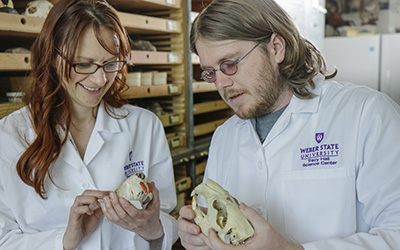
High Impact Educational Experiences
What Is a HIEE?
High Impact Educational Experiences promote student learning through curricular and co-curricular activities that are intentionally designed to foster active and integrative student engagement by utilizing multiple impact strategies.
Key Elements of HIEE: Impact Strategies
 Research on good college teaching and learning (Chickering and Gamson, 1987; Ewell and Jones, 1996; Kuh and O’Donnell, 2014) has established that high impact learning experiences allow students to personally invest themselves, develop meaningful relationships with peers/faculty/staff through collaborative work, receive frequent feedback, actively pose and solve problems, experience real world applications of knowledge, reflect on their learning processes, disseminate what they have learned, interact with others who are not like themselves, and feel challenged to meet appropriately high levels of performance.
Research on good college teaching and learning (Chickering and Gamson, 1987; Ewell and Jones, 1996; Kuh and O’Donnell, 2014) has established that high impact learning experiences allow students to personally invest themselves, develop meaningful relationships with peers/faculty/staff through collaborative work, receive frequent feedback, actively pose and solve problems, experience real world applications of knowledge, reflect on their learning processes, disseminate what they have learned, interact with others who are not like themselves, and feel challenged to meet appropriately high levels of performance.
These key elements of high impact educational experiences (Kuh and O’Donnell, 2014) are what we are calling impact strategies. Incorporating the following into learning activities will amplify the impact of the experience on the students’ learning:
- Performance expectations set at appropriately high levels (Performance Expectations)
- Significant investment of time and effort by students over an extended period of time (Personal Investment)
- Interactions with faculty, staff and peers about substantive matters (Meaningful Interactions)
- Experiences with diversity wherein students are exposed to and must contend with people and circumstances that differ from those which students are familiar (Diverse and Inclusive Experiences)
- Frequent, timely, and constructive feedback (Quality Feedback)
- Periodic, structured opportunities to reflect and integrate learning (Opportunities to Reflect and Integrate Learning)
- Opportunities to discover relevance of learning through real-world applications or through real-world/authentic experiences (Practical Application)
- Public dissemination of learning experience (Demonstration of Competence)
HIEE Taxonomy Instructional Tool
The HIEE taxonomy is a tool to help educators reflect on their teaching inside and outside the classroom. It is NOT meant to serve as a grading rubric for student work. Rather, this taxonomy is an instructional tool meant to encourage educators to thoughtfully consider and cultivate the impactfulness of each engagement opportunity.
Examples of How to Apply the Tool
Example: CAPES!
Example: Undergraduate Research & Creative Endeavors
Training Opportunities on HIEEs
Each year, the Teaching and Learning Forum facilitates numerous Communities of Practice (COP) on different high impact educational experiences. The community of practice provides a supportive environment to a small group of faculty and staff who want to explore and experiment with various teaching methods. Go to the Teaching and Learning Forum's COP site to learn more and sign up.
Additionally, we've launched a new program to help faculty and staff learn more about high impact strategies and how to incorporate them into their courses or programs. The program breaks up each impact strategy from the HIEE taxonomy into eight training modules.
The modules are available on Bridge, and can be completed at your own pace. Each module includes information about each impact strategy, its three levels and activities to help you integrate the strategy into current or new programs.
HIEE Centers/Offices at WSU
Weber State University faculty and staff provide students with numerous high impact educational experiences. Listed below are some of those HIEEs and the corresponding office or center that can help you get engaged with a particular HIEE.
HIEE |
Center/Office |
|---|---|
|
Proactive Advising
|
|
|
Internship (INT)
|
|
|
Community Engaged Learning (CEL)
|
|
|
First Year Experience Class (FYE)
|
First Year Experience Program |
|
Honors Class (HNRS)
|
Honors Program |
|
International Experiences
|
Study Abroad Program |
|
Undergraduate Research (CRE)
|
Office of Undergraduate Research |
|
Peer Mentor
|
Peer Mentoring Programs |
|
Leadership Experience
|
Student Involvement and Leadership |
|
Supplemental Instructor
|
Supplemental Instruction Program |
|
Sustainability Class (SUS)
|
Sustainability Practices and Research Center (SPARC) |
|
Project-based Learning
|
Bachelor of Interdisciplinary Studies (BIS) Program |
For more information, please contact the Student Success Engagement Committee Co-chairs:
Brenda Marsteller Kowalewski
Associate Provost for High Impact Programs and Faculty Development
bkowalewski@weber.edu
MA 317B
Jeff Hurst
Dean of Students
jhurst@weber.edu
MA 317A
